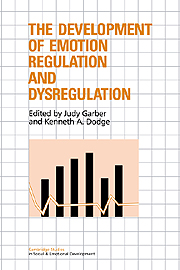Book contents
- Frontmatter
- Contents
- List of contributors
- Preface
- Part I Introduction
- Part II Early development
- 2 Contributions from the study of high-risk populations to understanding the development of emotion regulation
- 3 Development of emotion expression during infancy: General course and patterns of individual difference
- 4 Infant social referencing
- 5 Relationships, talk about feelings, and the development of affect regulation in early childhood
- Part III Physiological regulation
- Part IV Cognitive regulation
- Part V Psychopathology
- Part VI Integration
- Author index
- Subject index
3 - Development of emotion expression during infancy: General course and patterns of individual difference
Published online by Cambridge University Press: 26 March 2010
- Frontmatter
- Contents
- List of contributors
- Preface
- Part I Introduction
- Part II Early development
- 2 Contributions from the study of high-risk populations to understanding the development of emotion regulation
- 3 Development of emotion expression during infancy: General course and patterns of individual difference
- 4 Infant social referencing
- 5 Relationships, talk about feelings, and the development of affect regulation in early childhood
- Part III Physiological regulation
- Part IV Cognitive regulation
- Part V Psychopathology
- Part VI Integration
- Author index
- Subject index
Summary
Human emotions are biologically rooted; they are part of a common mammalian heritage that we share with other animals. In humans, however, the emotions have a greater range and show far greater developmental plasticity than found in any other species (Darwin, 1872; Ekman, 1973). In the case of humans, we readily recognize that considerable differences exist in the activation and display of emotions across individuals and that emotions are shaped by cultural and familial forces. What is not so readily understood is the means by which children acquire mature forms of expressive behavior and how their emotions become entrained to specific cultures and family circumstances.
The issue at hand has been broadly defined as one of “emotion socialization.” Although the study of the development of emotion expression dates back to Katharine Bridges's early observational studies of infants in hospitals and children in day care (1931, 1932) and early emotion perception and production studies (Gates, 1923; Odom & Lemond, 1972), it is only recently that the field has begun to move beyond the classic age-comparative studies (which show, convincingly enough, that children become more and more adultlike in their expressive behavior as they mature) to an interactional analysis that is informed by general systems theory. According to this more contemporary perspective, emotional development is seen as something that occurs within individuals but emerges as a product of mutually influential interaction within a particular kind of social ecology.
- Type
- Chapter
- Information
- The Development of Emotion Regulation and Dysregulation , pp. 49 - 68Publisher: Cambridge University PressPrint publication year: 1991
- 21
- Cited by

